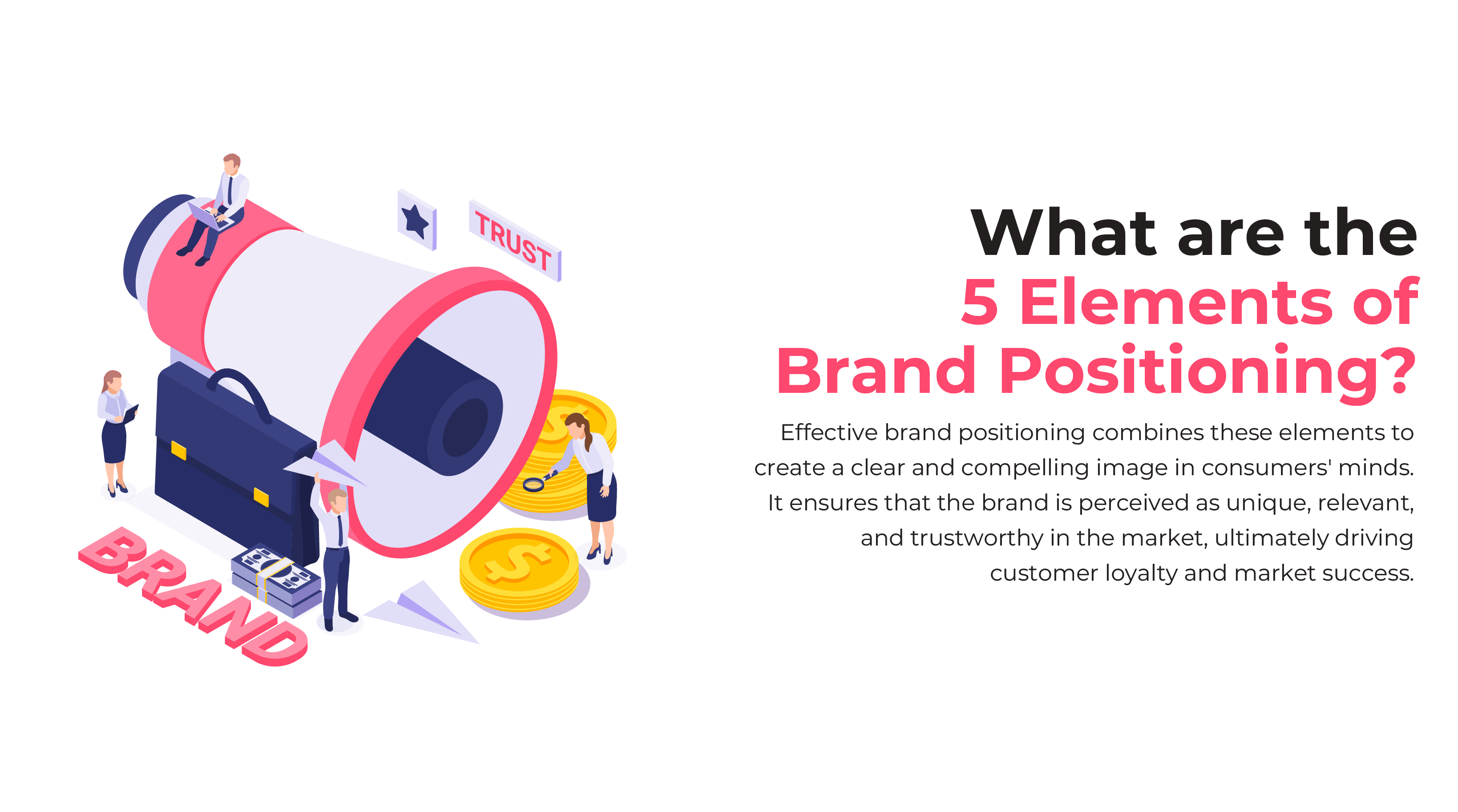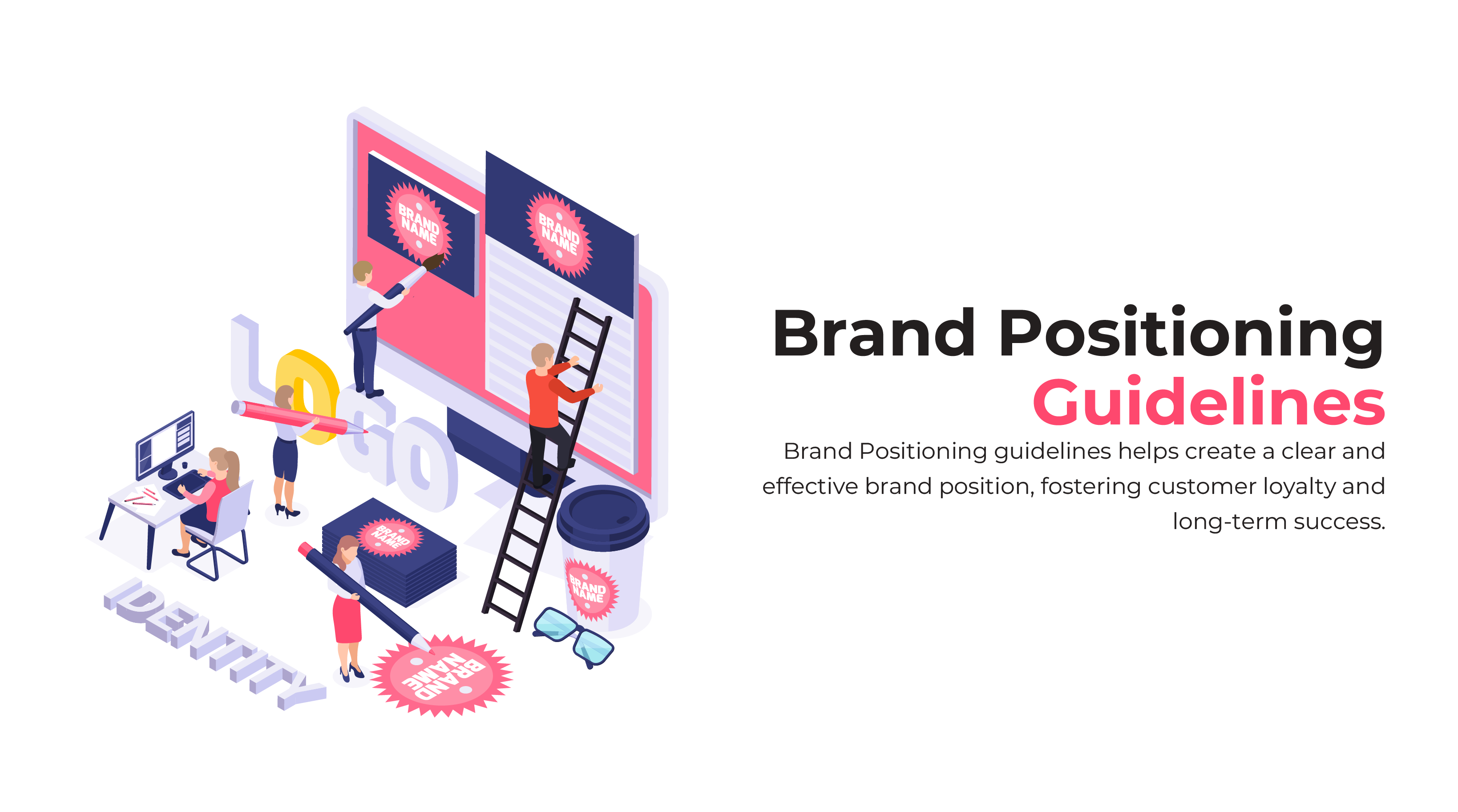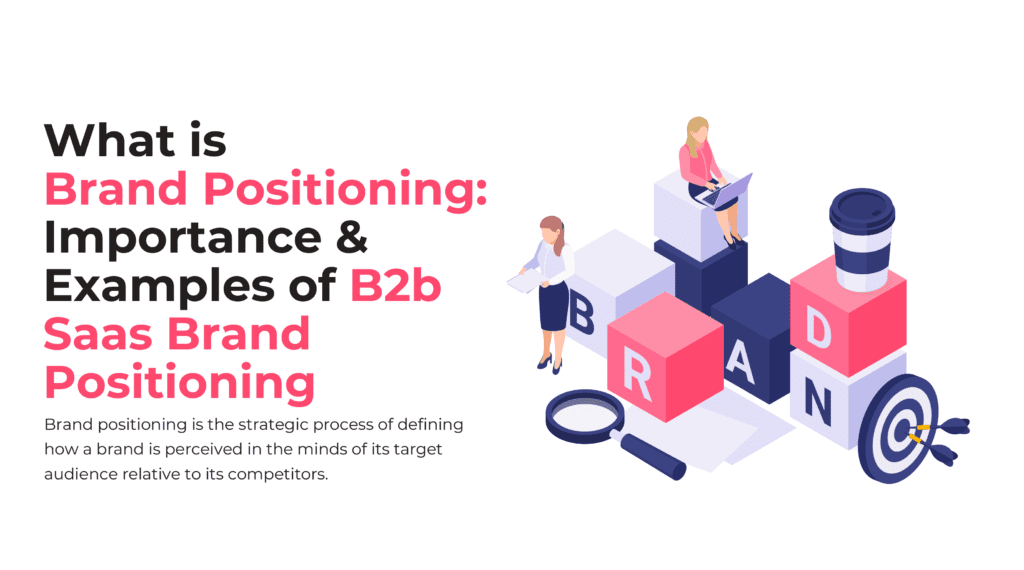Introduction
Brand positioning is the strategic process of defining how a brand is perceived in the minds of its target audience relative to its competitors. It’s about creating a distinct and favorable image of the brand in the market. To do this, brands need to identify their unique value proposition, which includes their core values, benefits, and attributes.
Effective brand positioning involves three key elements: Target Audience, Competitive Analysis and Unique Selling Proposition (USP).
Once a brand establishes its position, it can create marketing campaigns, messaging, and branding strategies that consistently convey this positioning. Over time, this reinforces the brand’s identity and builds customer loyalty, ultimately leading to a strong and enduring market presence.
What Is Brand Positioning In Marketing?

Brand positioning in marketing is the deliberate strategy of establishing a distinct and compelling image for a brand in the minds of its target customers. It’s about defining where a brand stands in relation to competitors, emphasizing its unique attributes, and communicating these differences effectively.
This positioning shapes consumer perceptions, influences purchase decisions, and builds brand loyalty. It’s not just about what a brand offers but also how it’s perceived by consumers, helping to create a memorable and desirable identity in a crowded marketplace.
Effective brand positioning aligns a brand’s messaging, values, and benefits with the specific needs and preferences of its target audience, fostering a strong and lasting connection with customers.
10 Benefits Of Brand Positioning

Brand positioning offers several key benefits:
1. Differentiation: It sets a brand apart from competitors by highlighting its unique attributes, creating a distinct identity in the market.
2. Consumer Attraction: Positioning helps attract and retain customers by resonating with their needs and preferences, increasing brand loyalty.
3. Premium Pricing: A well-positioned brand can often command higher prices, as consumers perceive it as offering greater value or quality.
4. Brand Recognition: Clear positioning makes a brand more memorable and recognizable, aiding in customer recall and brand recall.
5. Consistency: It provides a consistent framework for marketing efforts, ensuring that messaging and branding align with the brand’s identity.
6. Targeted Communication: Effective positioning allows brands to tailor their marketing messages to specific customer segments, increasing relevance and engagement.
7. Competitive Advantage: It helps brands adapt to changing market dynamics and maintain a competitive edge by responding strategically to shifts in consumer preferences and market trends.
8. Long-Term Success: Well-defined positioning contributes to a brand’s long-term success, fostering enduring relationships with customers and reducing vulnerability to market fluctuations.
9. Brand Loyalty: It encourages repeat purchases and brand advocacy, as consumers connect with the brand’s distinct personality and value proposition.
10. Growth Opportunities: Brands with strong positioning can explore new markets, product extensions, and partnerships more effectively, leveraging their established reputation and credibility.
What Are The 5 Elements Of Brand Positioning?

Brand positioning involves five key elements:
1. Target Audience: Identifying the specific group of consumers a brand aims to reach is essential. Understanding their demographics, psychographics, and preferences helps tailor messaging effectively.
2. Competitive Analysis: Thoroughly assessing competitors in the market is crucial. It allows a brand to identify gaps, opportunities, and the unique qualities that set it apart.
3. Unique Value Proposition (UVP): The UVP is what distinguishes a brand from its competitors. It encapsulates the core benefits, features, and values that make the brand appealing to its target audience.
4. Brand Promise: This element defines what customers can expect from the brand consistently. It encompasses the commitment to deliver on the UVP and establishes trust and credibility with consumers.
5. Brand Personality: Brand personality humanizes the brand, giving it distinct traits and characteristics. It helps consumers relate to the brand on a personal level and influences their emotional connection with it.
Effective brand positioning combines these elements to create a clear and compelling image in consumers’ minds. It ensures that the brand is perceived as unique, relevant, and trustworthy in the market, ultimately driving customer loyalty and market success.
Brand Positioning Examples
Certainly, here are a few brand positioning examples:
1. Volvo: Volvo positions itself as a brand focused on safety and reliability. Their tagline “For Life” emphasizes the commitment to protecting people, making them the go-to choice for families concerned about safety.
2. Apple: Apple positions itself as a brand that delivers innovative, user-friendly technology. Their “Think Different” campaign encouraged customers to embrace individuality and creativity, aligning Apple with cutting-edge design and functionality.
3. Coca-Cola: Coca-Cola positions itself as a brand associated with happiness and refreshment. The “Open Happiness” campaign highlights the emotional experience of enjoying a Coke and fostering positive moments.
4. Tesla: Tesla positions itself as a leader in sustainable transportation. The brand’s focus on electric vehicles and renewable energy aligns with their mission to accelerate the world’s transition to sustainable energy.
5. Nike: Nike positions itself as a brand that empowers athletes of all levels. Their “Just Do It” slogan encourages consumers to push their limits, creating a connection between the brand and personal achievement.
These examples demonstrate how effective brand positioning helps create a distinct image in consumers’ minds, allowing brands to connect with their target audience and stand out in competitive markets.
8 Brand Positioning Strategies To Use In 2024

Brand positioning strategies are deliberate approaches that brands use to establish a unique and compelling identity in the minds of their target audience. Here are some key strategies:
1. Differentiation: Brands focus on attributes that set them apart from competitors, whether it’s product features, quality, or values, creating a distinct position in the market.
2. Price Leadership: Some brands position themselves as offering premium quality or luxury, allowing them to command higher prices. Others focus on affordability, appealing to price-conscious consumers.
3. Niche Positioning: Brands can target a specific niche market segment with tailored products or messaging, addressing unique needs and preferences.
4. Problem Solving: Positioning as a solution provider helps brands address specific consumer problems or pain points, making their products or services indispensable.
5. Cultural Relevance: Brands can align with cultural trends, values, or movements, reflecting the aspirations and beliefs of their target audience.
6. User Experience: Brands can position themselves as providing exceptional customer service or a superior user experience, fostering loyalty through exceptional support and convenience.
7. Product Attributes: Highlighting unique product attributes, such as sustainability, technology, or design, can be a powerful positioning strategy.
8. Emotional Appeal: Brands may focus on evoking strong emotions, building connections that transcend product features and tap into consumers’ feelings and desires.
Effective brand positioning strategies should align with a brand’s values, resonate with its target audience, and reflect a genuine commitment to delivering on the brand promise.
What Are The 8 Brand Positioning Components?
Brand positioning consists of several key components that work together to shape a brand’s image and perception:
1. Target Audience: Identifying the specific group of consumers a brand wants to reach is fundamental. Understanding their demographics, behaviors, and preferences helps tailor messaging effectively.
2. Competitive Analysis: Thoroughly assessing competitors in the market is crucial. It allows a brand to identify gaps, opportunities, and the unique qualities that set it apart.
3. Unique Value Proposition (UVP): The UVP encapsulates the core benefits, features, and values that make the brand appealing to its target audience. It defines what the brand promises to deliver.
4. Brand Promise: This component defines what customers can consistently expect from the brand. It includes the commitment to deliver on the UVP and establishes trust and credibility with consumers.
5. Brand Personality: Brand personality humanizes the brand, giving it distinct traits and characteristics. It helps consumers relate to the brand on a personal level and influences their emotional connection with it.
6. Positioning Statement: A concise, clear statement that summarizes the brand’s positioning, target audience, and unique value in the market. It serves as a guiding message for marketing and communication efforts.
7. Brand Associations: These are the mental connections and perceptions that consumers associate with the brand. They can be based on product quality, values, experiences, or emotions.
8. Messaging and Communication: Brand positioning informs all messaging and communication efforts, ensuring that they consistently convey the brand’s identity and value to the target audience.
These components work in tandem to create a distinct and compelling brand position in the minds of consumers, ultimately driving brand recognition, loyalty, and success in the marketplace.
Brand Positioning Guidelines To Follow in 2024

Brand positioning guidelines are essential for creating a consistent and effective brand image:
1. Define Your Target Audience: Clearly identify and understand your target consumers, including their needs, preferences, and behaviors.
2. Analyze Competitors: Thoroughly research your competitors to identify gaps and opportunities in the market.
3. Unique Value Proposition (UVP): Determine what sets your brand apart, emphasizing its unique benefits, values, and attributes.
4. Brand Promise: Establish a commitment to consistently deliver on your UVP, building trust with customers.
5. Brand Personality: Define the brand’s personality traits and characteristics to humanize it and create a relatable identity.
6. Positioning Statement: Craft a concise statement summarizing your brand’s positioning, target audience, and unique value.
7. Messaging Consistency: Ensure all brand communications, from advertising to customer service, align with your positioning and deliver a unified message.
8. Consumer-Centric Approach: Keep the focus on addressing customer needs and solving their problems to maintain relevance.
9. Adaptability: Be ready to adjust your positioning to respond to changing market dynamics and consumer preferences.
10. Monitor and Refine: Continuously assess how your brand is perceived and adjust your positioning if necessary to stay competitive and resonant with your audience.
Following these guidelines helps create a clear and effective brand position, fostering customer loyalty and long-term success.
How Proper Brand Positioning Can Help You Improve Your B2B SaaS Business
Proper brand positioning is crucial for improving a B2B SaaS (Software as a Service) business in several ways:
1. Competitive Differentiation: Effective positioning sets your SaaS offering apart from competitors by highlighting unique features, benefits, or a specialized niche. This differentiation helps attract and retain customers.
2. Targeted Marketing: Knowing your brand’s position allows you to create targeted marketing campaigns tailored to specific customer segments. This increases the relevance of your messaging, improving lead generation and conversion rates.
3. Pricing Power: A well-positioned brand can often command higher prices, as customers perceive greater value. This enhances revenue and profitability.
4. Trust and Credibility: Clear positioning that consistently delivers on promises builds trust and credibility among your customer base, reducing churn and increasing customer loyalty.
5. Market Expansion: Strong brand positioning facilitates expansion into new markets or industries by leveraging your established reputation and credibility.
6. Product Development: Understanding your position helps inform product development efforts, ensuring that new features align with customer needs and your brand identity.
7. Partnering Opportunities: Brands with a strong position may attract strategic partners and collaborations, opening new avenues for growth.
8. Thought Leadership: A well-defined brand position can establish your company as an industry thought leader, attracting attention and trust from potential customers and investors.
9. Employee Engagement: Clear brand positioning also benefits internal stakeholders, helping employees understand the company’s mission and values, which can improve teamwork and morale.
10. Scalability: As your brand’s reputation grows, your business can scale more efficiently, attracting both customers and top talent.
In the competitive B2B SaaS landscape, proper brand positioning is essential for gaining a competitive edge, building trust, and fostering sustainable growth. It influences how customers perceive your solution and can be a key driver of success in the industry.
Conclusion

In conclusion, brand positioning is a vital strategic tool for businesses seeking to thrive in a competitive marketplace. By defining a brand’s unique value proposition, target audience, and messaging, it establishes a distinct and memorable identity that resonates with consumers. This identity, when consistently delivered upon, builds trust, loyalty, and differentiation from competitors.
The benefits of effective brand positioning are far-reaching. It can enhance a brand’s competitiveness, support premium pricing, and drive customer loyalty. It also empowers businesses to adapt to changing market dynamics and explore growth opportunities. Beyond financial gains, it fosters a sense of purpose and unity among employees, contributing to a company’s internal culture.
In the context of B2B SaaS businesses, where technology solutions abound, proper brand positioning is particularly critical. It allows companies to articulate the unique advantages of their software, connect with target audiences, and establish trust in their ability to deliver on promises. Ultimately, it’s a strategic investment that not only improves a business’s bottom line but also its resilience, reputation, and long-term success in a dynamic and evolving landscape.
Ready to supercharge your B2B SaaS brand’s success? Dive into the latest insights at Revvgrowth.com now and unlock the secrets to strategic marketing in the digital era!”
Read More: B2B SaaS Content Moderation in 2024: Best Practices, Tools, and Guidelines


